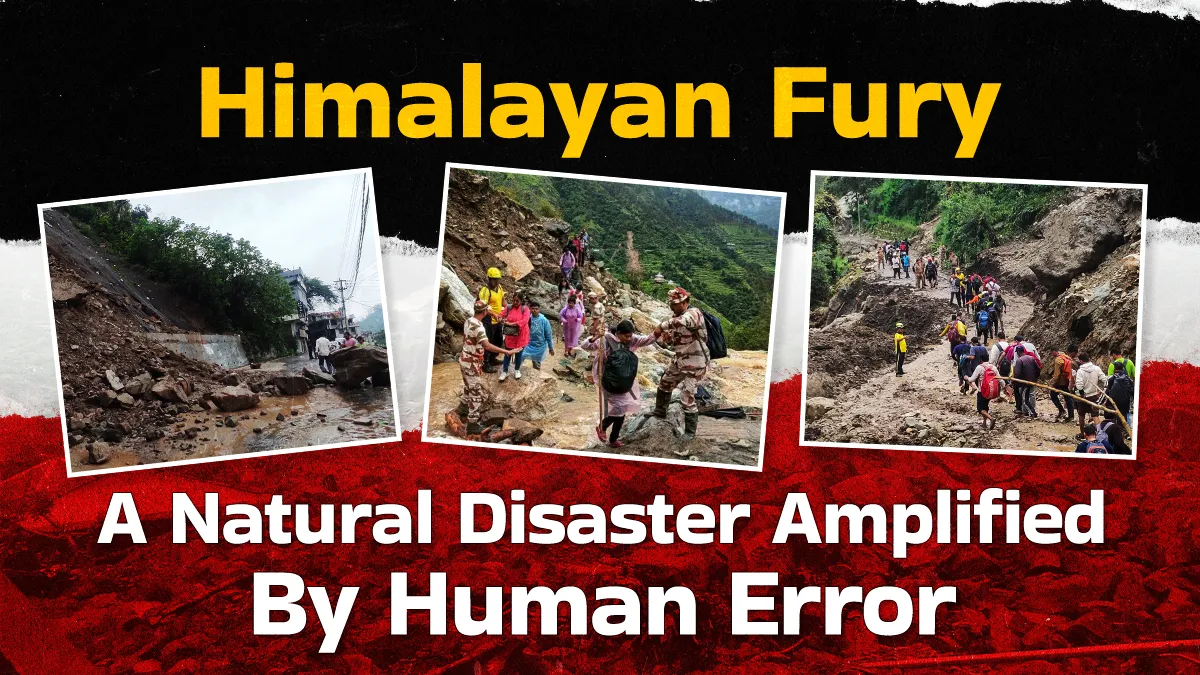- By Akansha Pandey
- Wed, 02 Jul 2025 08:09 PM (IST)
- Source:JND
The monsoon season in India brings not just rainfall but also destruction to various parts of the country, with several hill states reporting landslides and floods in the wake of heavy rains. Himachal Pradesh witnessed the adverse effects of weather on Tuesday, July 1, as cloudburst and flash floods due to heavy rains devastated Mandi district of the state. The floods left a trail of destruction as major loss of lives and property was reported. Several people went missing, animals were swept away, and houses and agricultural land were damaged. Due to the heavy rains in Shimla on Monday morning, a five-storey building collapsed within seconds. Earlier on Sunday, a cloudburst in Uttarakhand triggered widespread damage and chaos, leaving several workers missing, causing landslides and disrupting key pilgrimage routes in Uttarakhand.
For the past two decades, India has been experiencing irregular weather patterns with occurrence of heavy rains before their schedule, leading to an increase in incidents of cloudbursts, landslides and earthquakes. Himachal Pradesh recorded 135 mm of rainfall in June, 34 per cent above the normal of 101 mm, making it the 21st highest June rainfall since 1901. The record remains at 252.7 mm in 1971, according to a news agency PTI report.
Why Are Hilly Regions More Vulnerable To Disasters
India is home to the world's highest mountain range, the Himalayas, formed by the collision between the Indian and Eurasian tectonic plates. The Indian plate continues to move northward toward China at a rate of about 5 cm per year, generating immense geological stress. This constant pressure weakens the rock structures, making the region highly susceptible to earthquakes and landslides. These tectonic movements contribute to frequent natural disasters. Besides the Himalayas, other regions such as the Northeastern hill ranges, the Western Ghats, the Nilgiris, the Eastern Ghats, and the Vindhyas are also significantly affected by hydro-geological hazards like landslides and avalanches.
How Urbanisation Leads Deforestation
The devastation caused by natural disasters is multiplied by human activities such as deforestation, urbanisation and excessive tourism. These activities disturb the natural eco-system, cause landslides, soil erosion and other natural calamities. A large number of forests are being cleared to make way for roads, new homes and commercial buildings. The increased demand for land leads to a loss of greenery which harms the ecosystem. Rapidly growing urban development, more industries and harmful methods of farming are leading to high rates of deforestation and land degradation in India. These can cause loss of biodiversity, put pressure on our ecosystem and lead to global warming, thus they need to be addressed immediately.
How Tourism Becomes Disastrous
Due to the heavy influx of tourists and the expansion of the economy, the pattern of land use and the environmental balance are changing. The major hill stations of North India, such as Srinagar, Jammu, Shimla, Dehradun, Darjeeling, Gangtok, Shillong, Kohima and Aizawl are vulnerable to climate-related threats because of their unique geographical structure and seismic sensitivity. Human activities like uncontrolled urbanisation, the cutting of trees and forests, and improper land use further increase this risk. Moreover, excessive tourism is also a major problem, which requires better resource management and policies to tackle the hazards.
The economy of a region like Himachal Pradesh is largely dependent on tourism and with the increasing footfall every year, the hill state is witnessing infrastructural changes to cater these tourists. Various facilities like multi-storied buildings, hotels, restaurants and car parking are being built while ignoring the environmental regulations.
Challenges Of Urban Development In Himachal Pradesh
The mountains in which Himachal Pradesh is located are young and constantly growing, and the steep slopes are not very stable. The hills are fragile and prone to landslides and earthquakes, which means that these areas may not be suitable for modernisation. According to the State Disaster Management Authority, the hills have increasingly become more vulnerable due to rapid deforestation, road cutting, terracing and cultivation of crops which require intense watering. The hill state has also been witnessing a rising number of road accidents as improved road connectivity facilitates higher traffic, the SDMA site read.
Despite the hazards, the state has been making plans to develop infrastructure to make arrangements for the millions of tourists coming there. The state has been witnessing the construction of new heliports in all the district headquarters of the state, including remote and tribal areas. The people of Himachal Pradesh are reeling under the impact of the so-called economic development inflicted by four-lane roads, hydropower projects and tourism.
There are 17,120 landslide-prone areas in the state, according to a report by the Geological Survey of India. And 2003 data from the Government of India suggested that 97.42 per cent of Himachal Pradesh’s areas are prone to landslides. The SDMA has identified some of the most frequented tourist spots of Himachal Pradesh – Chamba, Kullu, Kinnaur, Shimla, Mandi, Lahaul and Spiti – among the cities most vulnerable to landslides and floods.
Pollution Worsening Situation
Helicopters spread more pollution in the environment than road transport. Greenhouse gases emitted by helicopters pollute the environment and increase the temperature. According to a 2020 report by the Union Ministry of Earth Sciences, India's average temperature has increased by 0.7 degrees Celsius from 1901 to 2018. The temperature of the Hindu Kush Himalaya has increased by 1.3 degrees Celsius from 1951 to 2014. Many areas of the Hindu Kush Himalaya have seen a decrease in snowfall and retreat of glaciers in recent decades.
India’s fragile hill ecosystems are increasingly vulnerable due to a dangerous mix of natural forces and human-induced pressures. As climate change accelerates, the urgency to adopt sustainable development practices grows stronger. Without immediate and informed action, the cost in lives, biodiversity, and long-term environmental stability will only continue to rise.

